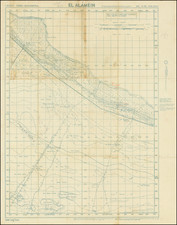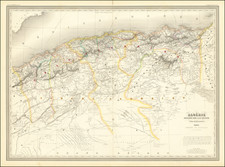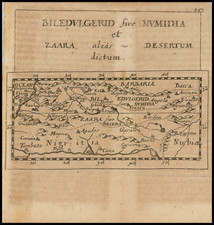Rare first state of Camocio's rare plan of Bizerte in Tunisia, publishedi n Venice.
The map is oriented with South at the top and illustrates the fortified town, harbor and citadelle at Bizerte.
Bizerte
Arab armies took Bizerte in 647 in their first invasion of the area, but the city reverted to control from Constantinople until the Byzantines were defeated and finally driven from North Africa in 695–98. The troops of Charles V of the Holy Roman Empire captured the city in 1535, but the Ottoman Turks took it back in 1574, as part of the reconquest of Tunis under Kapudan Pasha Uluç Ali Reis. The conquest of Tunis in 1574 marked the final conquest of Tunis by the Ottoman Empire over the Spanish Empire. This was an event of great significance as it decided that North Africa would be under Muslim rather than Christian rule and ended the Spanish Conquista of Northern Africa, which started in 1497 under the Catholic Monarchs of Spain. The capture of Tunis in 1574 "sealed the Ottoman domination of the eastern and central Maghreb".
The city then became a Barbary Pirate corsair harbor and struggled against the French and the Venetians.
The Lafreri School is a commonly used name for a group of mapmakers, engravers, and publishers who worked in Rome and Venice from ca. 1544 to 1585. The makers, who were loosely connected via business partnerships and collaborations, created maps that were then bound into composite atlases; the maps would be chosen based on the buyer or compiler’s interests. As the maps were initially published as separate-sheets, the style and size of maps included under the umbrella of the “School” differed widely. These differences can also be seen in the surviving Lafreri atlases, which have maps bound in with varying formats including as folded maps, maps with wide, trimmed, or added margins, smaller maps, etc.
The most famous mapmakers of the School included Giacomo Gastaldi and Paolo Forlani, among others. The School’s namesake, Antonio Lafreri, was a map and printseller. His 1572 catalog of his stock, entitled Indice Delle Tavole Moderne Di Geografia Della Maggior Parte Del Mondo, has a similar title to many of the composite atlases and thus his name became associated with the entire output of the larger group.










![[Capture of Mahdia in 1550] Vera urbis Africae descriptio, p Illust. D. Viceregem Sicilae, & Antonium Doriam, Caroli. v. Imper inuictiss. Duces iam expugnatae. 1550](https://storage.googleapis.com/raremaps/img/small/78592.jpg)


![[Governor Charles George Gordon's Route from Suakin to Khartoum 28 Feby to 13 March]](https://storage.googleapis.com/raremaps/img/small/99190.jpg)
![[Asilah, Morocco] Arzilla](https://storage.googleapis.com/raremaps/img/small/41197.jpg)